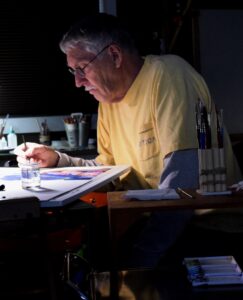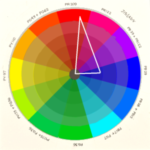John’s Blog
I have become hypnotized by watercolor. It’s the only medium where color can take a sideline to other characteristics. Watercolor has an existence of its own, and is capable of making art all by itself. I have spent the last 5 years trying to lose my addiction to reality by concentrating on shape and value, rather than color. As it turns out, watercolor is the perfect medium for that kind of experimentation.
I’m more engineer than artist. I spend as  much time testing paints as I do painting with them. Watercolor paints are not like other wet media; when watercolor dries there is nothing left on the paper but pure pigment. The size of the pigment particles makes all the difference in the world. Once I realized this, paint selection became less about the color, and more about other characteristics that are unique when pigments are suspended in water.
much time testing paints as I do painting with them. Watercolor paints are not like other wet media; when watercolor dries there is nothing left on the paper but pure pigment. The size of the pigment particles makes all the difference in the world. Once I realized this, paint selection became less about the color, and more about other characteristics that are unique when pigments are suspended in water.
I have been applying this idea to my work in an attempt to loosen up my paintings by concentrating on shape and value, and sacrificing color accuracy for other characteristics like transparency, texture and edging.
Protecting and Recovering Light: Introduction
Introductory Notes and Self Congratulations There are many different names for this material. Resist, Masking Fluid, Frisket, Liquid Latex, etc. I will be referring to it simply as 'resist', just because this is quicker and easier to type. A...
Protecting and Recovering Light: Using Resist
Resist (‘Masking Fluid’, ‘Frisket’, ‘Liquid Latex’, etc.) Testing Always test your resist with the paper you intend to use. Apply some full strength, and some diluted 1:1 with water. Let dry and lift. Try to determine if the paper is disturbed. ...
Protecting and Recovering Lights – A Table of Techniques
The left side of the table below lists a variety of techniques for preserving and recoving light. Across the chart lists different stages of drying: Before you start painting, While the paint is drying (3 sub-stages - Flow, Gloss, and Dull), and...
Many Ways to Gray: Introduction
I love grays and muted tones. Grays emphasize the colors nearby. Jeanne Dobie refers to this as ‘mouse power’. The ‘mouse’ colors are the supporting cast for the jewel-like colors. Whenever selecting a simple palette for a painting, the first...
Many Ways to Gray, Part 1: Neutral Tints
Over the last several years, there has been an influx of new ‘neutral tints’ introduced by manufacturers of artist paints almost as though there has been a new pigment discovered. In a way there has. There are new (20thC) pigments that are more...
Many Ways to Gray, Part 2: How to Make a Neutral
Whenever you want to mix any color, the easiest path will always be to mix two colors which are close to the color you desire. As a simple example, consider mixing a violet. You would choose a red that had a bluish component (like a rose or...
Many Ways to Gray, Part 3: Some Popular Neutral Tints
Let’s look at some of the most popular Neutral Tints and their formulas.Most of the neutral tints on the market are analogous dyads combined with a complement, or dulling pigment. An analogous dyad means two colors close together on the color...
Many Ways to Gray, Part 4: Magic Grays
Grays with 'Character' This section is not about neutral tints at all, but an approach to mixing grays with character. I’m sure at some point every watercolorist has mixed up a batch of paint thinking it will be a nice color only to end up with a...
Many Ways to Gray, Part 5: Mac’s Gray
Over the years each artist will undoubtedly develop many of their own favorite gray mixtures. Often these formulas are what paint manufacturers are using. With the constant influx of new pigment options, there are always new ways to make neutrals...
Three Blacks for Watercolorists
(Video Presentation) Many artists would never consider black for their palette. Here are some reasons a watercolorist might want to keep multiple blacks. [‘PAPA Members Present’ Zoom presentation, April 14, 2021]

